Case Based Questions Test: Magnetism & Matter - NEET MCQ
15 Questions MCQ Test Topic-wise MCQ Tests for NEET - Case Based Questions Test: Magnetism & Matter
Read the following text and answer the following questions on the basis of the same:
Earth’s magnetism: Earth’s magnetic field is caused by a dynamo effect. The effect works in the same way as a dynamo light on a bicycle. Magnets in the dynamo start spinning when the bicycle is pedaled, creating an electric current. The electricity is then used to turn on the light. This process also works in reverse. If you have a rotating electric current, it will create a magnetic field. On Earth, flowing liquid metal in the outer core of the planet generates electric currents. The rotation of Earth on its axis causes these electric currents to form a magnetic field which extends around the planet. The average magnetic field strength in the Earth's outer core was measured to be 25 Gauss, 50 times stronger than the magnetic field at the surface. The magnetic field is extremely important for sustaining life on Earth. Without it, we would be exposed to high amounts of radiation from the Sun and our atmosphere would be free to leak into space. This is likely what happened to the atmosphere on Mars. As Mars doesn’t have flowing liquid metal in its core, it doesn’t produce the same dynamo effect. This left the planet with a very weak magnetic field, allowing for its atmosphere to be stripped away by solar winds, leaving it uninhabitable. Based upon the study of lava flows throughout the world, it has been proposed that the Earth's magnetic field reverses at an average interval of approximately 300,000 years. However, the last such event occurred some 780,000 years ago.
Which of the followings is the reason for Earth’s magnetism?
Read the following text and answer the following questions on the basis of the same:
Earth’s magnetism: Earth’s magnetic field is caused by a dynamo effect. The effect works in the same way as a dynamo light on a bicycle. Magnets in the dynamo start spinning when the bicycle is pedaled, creating an electric current. The electricity is then used to turn on the light. This process also works in reverse. If you have a rotating electric current, it will create a magnetic field. On Earth, flowing liquid metal in the outer core of the planet generates electric currents. The rotation of Earth on its axis causes these electric currents to form a magnetic field which extends around the planet. The average magnetic field strength in the Earth's outer core was measured to be 25 Gauss, 50 times stronger than the magnetic field at the surface. The magnetic field is extremely important for sustaining life on Earth. Without it, we would be exposed to high amounts of radiation from the Sun and our atmosphere would be free to leak into space. This is likely what happened to the atmosphere on Mars. As Mars doesn’t have flowing liquid metal in its core, it doesn’t produce the same dynamo effect. This left the planet with a very weak magnetic field, allowing for its atmosphere to be stripped away by solar winds, leaving it uninhabitable. Based upon the study of lava flows throughout the world, it has been proposed that the Earth's magnetic field reverses at an average interval of approximately 300,000 years. However, the last such event occurred some 780,000 years ago.
Which planet has no own magnetic field?
Read the following text and answer the following questions on the basis of the same: Earth’s magnetism: Earth’s magnetic field is caused by a dynamo effect. The effect works in the same way as a dynamo light on a bicycle. Magnets in the dynamo start spinning when the bicycle is pedaled, creating an electric current. The electricity is then used to turn on the light. This process also works in reverse. If you have a rotating electric current, it will create a magnetic field. On Earth, flowing liquid metal in the outer core of the planet generates electric currents. The rotation of Earth on its axis causes these electric currents to form a magnetic field which extends around the planet. The average magnetic field strength in the Earth's outer core was measured to be 25 Gauss, 50 times stronger than the magnetic field at the surface. The magnetic field is extremely important for sustaining life on Earth. Without it, we would be exposed to high amounts of radiation from the Sun and our atmosphere would be free to leak into space. This is likely what happened to the atmosphere on Mars. As Mars doesn’t have flowing liquid metal in its core, it doesn’t produce the same dynamo effect. This left the planet with a very weak magnetic field, allowing for its atmosphere to be stripped away by solar winds, leaving it uninhabitable. Based upon the study of lava flows throughout the world, it has been proposed that the Earth's magnetic field reverses at an average interval of approximately 300,000 years. However, the last such event occurred some 780,000 years ago.
Which of the following statements is true?
Read the following text and answer the following questions on the basis of the same:
If we move into space and study the Earth's invisible magnetic field, it wouldn't really look like a bar magnet at all. Earth's magnetic field gets stretched out into a comet-like shape with a tail of magnetism that stretches millions of miles behind the earth, opposite to the Sun. The Sun has a wind of gas that pushes the earth's field from the left to the right in the picture.
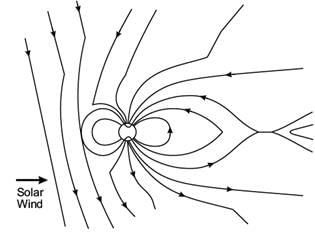
The core of the Earth is an electromagnet. Although the crust is solid, the core of the Earth is surrounded by a mixture of molten iron and nickle. The magnetic field of Earth is caused by currents of electricity that flow in the molten core. These currents are hundreds of miles wide and flow at thousands of miles per hour as the Earth rotates. The powerful magnetic field passes out through the core of the Earth, passes through the crust and enters space. This picture shows the solid inner core region ( inner circle) surrounded by a molten outer core (the area between the two circles). The currents flow in the outer core, travel outwards through the rest of the earth's interior. If the Earth rotated faster, it would have a stronger magnetic field.
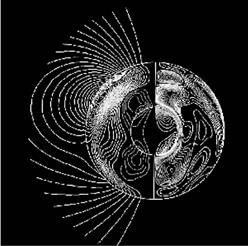
By the time the field has reached the surface of Earth, it has weakened a lot, but it is still strong enough to keep your compass needles pointed towards one of its poles. All magnets have two poles: a North Pole and a South Pole. The magnetic poles of earth are not fixed on the surface, but wander quite a bit. The pole in the Northern Hemisphere seems to be moving northwards in geographic latitude by about 10 kilometres per year by an average.
Earth’s magnetic field has a:
Read the following text and answer the following questions on the basis of the same: If we move into space and study the Earth's invisible magnetic field, it wouldn't really look like a bar magnet at all. Earth's magnetic field gets stretched out into a comet-like shape with a tail of magnetism that stretches millions of miles behind the earth, opposite to the Sun. The Sun has a wind of gas that pushes the earth's field from the left to the right in the picture.
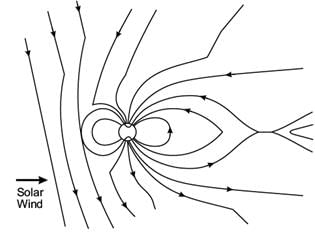
The core of the Earth is an electromagnet. Although the crust is solid, the core of the Earth is surrounded by a mixture of molten iron and nickle. The magnetic field of Earth is caused by currents of electricity that flow in the molten core. These currents are hundreds of miles wide and flow at thousands of miles per hour as the Earth rotates. The powerful magnetic field passes out through the core of the Earth, passes through the crust and enters space. This picture shows the solid inner core region ( inner circle) surrounded by a molten outer core (the area between the two circles). The currents flow in the outer core, travel outwards through the rest of the earth's interior. If the Earth rotated faster, it would have a stronger magnetic field.
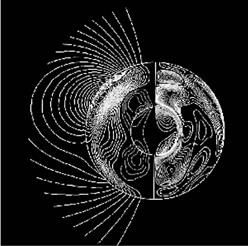
By the time the field has reached the surface of Earth, it has weakened a lot, but it is still strong enough to keep your compass needles pointed towards one of its poles. All magnets have two poles: a North Pole and a South Pole. The magnetic poles of earth are not fixed on the surface, but wander quite a bit. The pole in the Northern Hemisphere seems to be moving northwards in geographic latitude by about 10 kilometres per year by an average.
The magnetic poles of Earth are:
Read the following text and answer the following questions on the basis of the same: If we move into space and study the Earth's invisible magnetic field, it wouldn't really look like a bar magnet at all. Earth's magnetic field gets stretched out into a comet-like shape with a tail of magnetism that stretches millions of miles behind the earth, opposite to the Sun. The Sun has a wind of gas that pushes the earth's field from the left to the right in the picture.
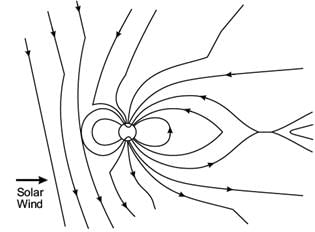
The core of the Earth is an electromagnet. Although the crust is solid, the core of the Earth is surrounded by a mixture of molten iron and nickle. The magnetic field of Earth is caused by currents of electricity that flow in the molten core. These currents are hundreds of miles wide and flow at thousands of miles per hour as the Earth rotates. The powerful magnetic field passes out through the core of the Earth, passes through the crust and enters space. This picture shows the solid inner core region ( inner circle) surrounded by a molten outer core (the area between the two circles). The currents flow in the outer core, travel outwards through the rest of the earth's interior. If the Earth rotated faster, it would have a stronger magnetic field.
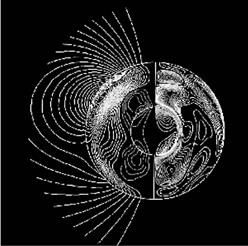
By the time the field has reached the surface of Earth, it has weakened a lot, but it is still strong enough to keep your compass needles pointed towards one of its poles. All magnets have two poles: a North Pole and a South Pole. The magnetic poles of earth are not fixed on the surface, but wander quite a bit. The pole in the Northern Hemisphere seems to be moving northwards in geographic latitude by about 10 kilometres per year by an average.
The Earth’s magnetism is due to:
Read the following text and answer the following questions on the basis of the same:
Super magnet
The term super magnet is a broad term and encompasses several families of rare-earth magnets that include seventeen elements in the periodic table; namely scandium, yttrium, and the fifteen lanthanides. These elements can be magnetized, but have Curie temperatures below room temperature. This means that in their pure form, their magnetism only appears at low temperatures. However, when they form compounds with transition metals such as iron, nickel, cobalt, etc. Curie temperature rises well above room temperature and they can be used effectively at higher temperatures as well. The main advantage they have over conventional magnets is that their greater strength allows for smaller, lighter magnets to be used. Super magnets are of two categories: (i) N eodymium magnet: These are made from an alloy of neodymium, iron, and boron. This material is currently the strongest known type of permanent magnet. It is typically used in the construction of head actuators in computer hard drives and has many electronic applications, such as electric motors, appliances, and magnetic resonance imaging (MRI). (ii) Samarium-cobalt magnet: These are made from an alloy of samarium and cobalt. This second strongest type of rare Earth magnet is also used in electronic motors, turbo-machinery, and because of its high temperature range tolerance may also have many applications for space travel, such as cryogenics and heat resistant machinery. Rare-earth magnets are extremely brittle and also vulnerable to corrosion, so they are usually plated or coated to protect them from breaking, chipping, or crumbling into powder. Since super magnets are about 10 times stronger than ordinary magnets, safe distance should be maintained otherwise these may damage mechanical watch, CRT monitor, pacemaker, credit cards, magnetically stored media etc.
These types of magnets are hazardous for health also. The greater force exerted by rare-earth magnets creates hazards that are not seen with other types of magnet. Magnets larger than a few centimeters are strong enough to cause injuries to body parts pinched between two magnets or a magnet and a metal surface, even causing broken bones. Neodymium permanent magnets lose their magnetism 5% every 100 years. So, in the truest sense Neodymium magnets may be considered as a permanent magnet.
Curie point of pure rare Earth elements is
Read the following text and answer the following questions on the basis of the same:
Super magnet The term super magnet is a broad term and encompasses several families of rare-earth magnets that include seventeen elements in the periodic table; namely scandium, yttrium, and the fifteen lanthanides. These elements can be magnetized, but have Curie temperatures below room temperature. This means that in their pure form, their magnetism only appears at low temperatures. However, when they form compounds with transition metals such as iron, nickel, cobalt, etc. Curie temperature rises well above room temperature and they can be used effectively at higher temperatures as well. The main advantage they have over conventional magnets is that their greater strength allows for smaller, lighter magnets to be used. Super magnets are of two categories: (i) Neodymium magnet: These are made from an alloy of neodymium, iron, and boron. This material is currently the strongest known type of permanent magnet. It is typically used in the construction of head actuators in computer hard drives and has many electronic applications, such as electric motors, appliances, and magnetic resonance imaging (MRI). (ii) Samarium-cobalt magnet: These are made from an alloy of samarium and cobalt. This second strongest type of rare Earth magnet is also used in electronic motors, turbo-machinery, and because of its high temperature range tolerance may also have many applications for space travel, such as cryogenics and heat resistant machinery. Rare-earth magnets are extremely brittle and also vulnerable to corrosion, so they are usually plated or coated to protect them from breaking, chipping, or crumbling into powder. Since super magnets are about 10 times stronger than ordinary magnets, safe distance should be maintained otherwise these may damage mechanical watch, CRT monitor, pacemaker, credit cards, magnetically stored media etc. These types of magnets are hazardous for health also. The greater force exerted by rare-earth magnets creates hazards that are not seen with other types of magnet. Magnets larger than a few centimeters are strong enough to cause injuries to body parts pinched between two magnets or a magnet and a metal surface, even causing broken bones. Neodymium permanent magnets lose their magnetism 5% every 100 years. So, in the truest sense Neodymium magnets may be considered as a permanent magnet.
Super magnets are about _____ time stronger than ordinary magnets.
Read the following text and answer the following questions on the basis of the same: Super magnet The term super magnet is a broad term and encompasses several families of rare-earth magnets that include seventeen elements in the periodic table; namely scandium, yttrium, and the fifteen lanthanides. These elements can be magnetized, but have Curie temperatures below room temperature. This means that in their pure form, their magnetism only appears at low temperatures. However, when they form compounds with transition metals such as iron, nickel, cobalt, etc. Curie temperature rises well above room temperature and they can be used effectively at higher temperatures as well. The main advantage they have over conventional magnets is that their greater strength allows for smaller, lighter magnets to be used. Super magnets are of two categories: (i) Neodymium magnet: These are made from an alloy of neodymium, iron, and boron. This material is currently the strongest known type of permanent magnet. It is typically used in the construction of head actuators in computer hard drives and has many electronic applications, such as electric motors, appliances, and magnetic resonance imaging (MRI). (ii) Samarium-cobalt magnet: These are made from an alloy of samarium and cobalt. This second strongest type of rare Earth magnet is also used in electronic motors, turbo-machinery, and because of its high temperature range tolerance may also have many applications for space travel, such as cryogenics and heat resistant machinery. Rare-earth magnets are extremely brittle and also vulnerable to corrosion, so they are usually plated or coated to protect them from breaking, chipping, or crumbling into powder. Since super magnets are about 10 times stronger than ordinary magnets, safe distance should be maintained otherwise these may damage mechanical watch, CRT monitor, pacemaker, credit cards, magnetically stored media etc. These types of magnets are hazardous for health also. The greater force exerted by rare-earth magnets creates hazards that are not seen with other types of magnet. Magnets larger than a few centimeters are strong enough to cause injuries to body parts pinched between two magnets or a magnet and a metal surface, even causing broken bones. Neodymium permanent magnets lose their magnetism 5% every 100 years. So, in the truest sense Neodymium magnets may be considered as a permanent magnet.
Neodymium permanent magnets lose their magnetism ____ % every 100 years.
Read the following text and answer the following questions on the basis of the same:
Earth’s magnetism: Earth’s magnetic field is caused by a dynamo effect. The effect works in the same way as a dynamo light on a bicycle. Magnets in the dynamo start spinning when the bicycle is pedaled, creating an electric current. The electricity is then used to turn on the light. This process also works in reverse. If you have a rotating electric current, it will create a magnetic field. On Earth, flowing of liquid metal in the outer core of the planet generates electric currents. The rotation of Earth on its axis causes these electric currents to form a magnetic field which extends around the planet. The average magnetic field strength in the Earth's outer core was measured to be 25 Gauss, 50 times stronger than the magnetic field at the surface. The magnetic field is extremely important for sustaining life on Earth. Without it, we would be exposed to high amounts of radiation from the Sun and our atmosphere would be free to leak into space. This is likely what happened to the atmosphere on Mars. As Mars doesn’t have flowing liquid metal in its core, it doesn’t produce the same dynamo effect. This left the planet with a very weak magnetic field, allowing for its atmosphere to be stripped away by solar winds, leaving it uninhabitable. Based upon the study of lava flows throughout the world, it has been proposed that the Earth's magnetic field reverses at an average interval of approximately 300,000 years. However, the last such event occurred some 780,000 years ago.
Electric current in the Earth’s body is generated due to:
Read the following text and answer the following questions on the basis of the same:
Earth’s magnetism: Earth’s magnetic field is caused by a dynamo effect. The effect works in the same way as a dynamo light on a bicycle. Magnets in the dynamo start spinning when the bicycle is pedaled, creating an electric current. The electricity is then used to turn on the light. This process also works in reverse. If you have a rotating electric current, it will create a magnetic field. On Earth, flowing of liquid metal in the outer core of the planet generates electric currents. The rotation of Earth on its axis causes these electric currents to form a magnetic field which extends around the planet. The average magnetic field strength in the Earth's outer core was measured to be 25 Gauss, 50 times stronger than the magnetic field at the surface. The magnetic field is extremely important for sustaining life on Earth. Without it, we would be exposed to high amounts of radiation from the Sun and our atmosphere would be free to leak into space. This is likely what happened to the atmosphere on Mars. As Mars doesn’t have flowing liquid metal in its core, it doesn’t produce the same dynamo effect. This left the planet with a very weak magnetic field, allowing for its atmosphere to be stripped away by solar winds, leaving it uninhabitable. Based upon the study of lava flows throughout the world, it has been proposed that the Earth's magnetic field reverses at an average interval of approximately 300,000 years. However, the last such event occurred some 780,000 years ago.
Average magnetic field strength in the Earth's outer core is:
Read the following text and answer the following questions on the basis of the same:
If we move into space and study the Earth's invisible magnetic field, it wouldn't really look like a bar magnet at all. Earth's magnetic field gets stretched out into a comet-like shape with a tail of magnetism that stretches millions of miles behind the earth, opposite to the Sun. The Sun has a wind of gas that pushes the earth's field from the left to the right in the picture.
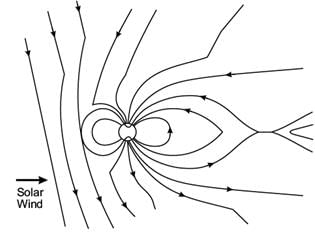
The core of the Earth is an electromagnet. Although the crust is solid, the core of the Earth is surrounded by a mixture of molten iron and nickle. The magnetic field of Earth is caused by currents of electricity that flow in the molten core. These currents are hundreds of miles wide and flow at thousands of miles per hour as the Earth rotates. The powerful magnetic field passes out through the core of the Earth, passes through the crust and enters space. This picture shows the solid inner core region ( inner circle) surrounded by a molten outer core (the area between the two circles). The currents flow in the outer core, travel outwards through the rest of the earth's interior. If the Earth rotated faster, it would have a stronger magnetic field.
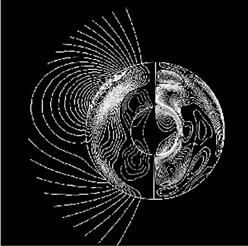
By the time the field has reached the surface of Earth, it has weakened a lot, but it is still strong enough to keep your compass needles pointed towards one of its poles. All magnets have two poles: a North Pole and a South Pole. The magnetic poles of earth are not fixed on the surface, but wander quite a bit. The pole in the Northern Hemisphere seems to be moving northwards in geographic latitude by about 10 kilometres per year by an average.
Core of the Earth is:
Read the following text and answer the following questions on the basis of the same:
If we move into space and study the Earth's invisible magnetic field, it wouldn't really look like a bar magnet at all. Earth's magnetic field gets stretched out into a comet-like shape with a tail of magnetism that stretches millions of miles behind the earth, opposite to the Sun. The Sun has a wind of gas that pushes the earth's field from the left to the right in the picture.
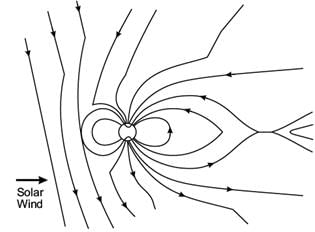
The core of the Earth is an electromagnet. Although the crust is solid, the core of the Earth is surrounded by a mixture of molten iron and nickle. The magnetic field of Earth is caused by currents of electricity that flow in the molten core. These currents are hundreds of miles wide and flow at thousands of miles per hour as the Earth rotates. The powerful magnetic field passes out through the core of the Earth, passes through the crust and enters space. This picture shows the solid inner core region ( inner circle) surrounded by a molten outer core (the area between the two circles). The currents flow in the outer core, travel outwards through the rest of the earth's interior. If the Earth rotated faster, it would have a stronger magnetic field.

By the time the field has reached the surface of Earth, it has weakened a lot, but it is still strong enough to keep your compass needles pointed towards one of its poles. All magnets have two poles: a North Pole and a South Pole. The magnetic poles of earth are not fixed on the surface, but wander quite a bit. The pole in the Northern Hemisphere seems to be moving northwards in geographic latitude by about 10 kilometres per year by an average.
Earth’s magnetic field may increase if:
Read the following text and answer the following questions on the basis of the same:
Super magnet The term super magnet is a broad term and encompasses several families of rare-earth magnets that include seventeen elements in the periodic table; namely scandium, yttrium, and the fifteen lanthanides. These elements can be magnetized, but have Curie temperatures below room temperature. This means that in their pure form, their magnetism only appears at low temperatures. However, when they form compounds with transition metals such as iron, nickel, cobalt, etc. Curie temperature rises well above room temperature and they can be used effectively at higher temperatures as well. The main advantage they have over conventional magnets is that their greater strength allows for smaller, lighter magnets to be used. Super magnets are of two categories:
(i) Neodymium magnet: These are made from an alloy of neodymium, iron, and boron. This material is currently the strongest known type of permanent magnet. It is typically used in the construction of head actuators in computer hard drives and has many electronic applications, such as electric motors, appliances, and magnetic resonance imaging (MRI).
(ii) Samarium-cobalt magnet: These are made from an alloy of samarium and cobalt. This second strongest type of rare Earth magnet is also used in electronic motors, turbo-machinery, and because of its high temperature range tolerance may also have many applications for space travel, such as cryogenics and heat resistant machinery. Rare-earth magnets are extremely brittle and also vulnerable to corrosion, so they are usually plated or coated to protect them from breaking, chipping, or crumbling into powder. Since super magnets are about 10 times stronger than ordinary magnets, safe distance should be maintained otherwise these may damage mechanical watch, CRT monitor, pacemaker, credit cards, magnetically stored media etc. These types of magnets are hazardous for health also. The greater force exerted by rare-earth magnets creates hazards that are not seen with other types of magnet. Magnets larger than a few centimeters are strong enough to cause injuries to body parts pinched between two magnets or a magnet and a metal surface, even causing broken bones. Neodymium permanent magnets lose their magnetism 5% every 100 years. So, in the truest sense Neodymium magnets may be considered as a permanent magnet.
Neodymium and Samarium are
Read the following text and answer the following questions on the basis of the same:
Super magnet The term super magnet is a broad term and encompasses several families of rare-earth magnets that include seventeen elements in the periodic table; namely scandium, yttrium, and the fifteen lanthanides. These elements can be magnetized, but have Curie temperatures below room temperature. This means that in their pure form, their magnetism only appears at low temperatures. However, when they form compounds with transition metals such as iron, nickel, cobalt, etc. Curie temperature rises well above room temperature and they can be used effectively at higher temperatures as well. The main advantage they have over conventional magnets is that their greater strength allows for smaller, lighter magnets to be used. Super magnets are of two categories:
(i) Neodymium magnet: These are made from an alloy of neodymium, iron, and boron. This material is currently the strongest known type of permanent magnet. It is typically used in the construction of head actuators in computer hard drives and has many electronic applications, such as electric motors, appliances, and magnetic resonance imaging (MRI).
(ii) Samarium-cobalt magnet: These are made from an alloy of samarium and cobalt. This second strongest type of rare Earth magnet is also used in electronic motors, turbo-machinery, and because of its high temperature range tolerance may also have many applications for space travel, such as cryogenics and heat resistant machinery. Rare-earth magnets are extremely brittle and also vulnerable to corrosion, so they are usually plated or coated to protect them from breaking, chipping, or crumbling into powder. Since super magnets are about 10 times stronger than ordinary magnets, safe distance should be maintained otherwise these may damage mechanical watch, CRT monitor, pacemaker, credit cards, magnetically stored media etc. These types of magnets are hazardous for health also. The greater force exerted by rare-earth magnets creates hazards that are not seen with other types of magnet. Magnets larger than a few centimeters are strong enough to cause injuries to body parts pinched between two magnets or a magnet and a metal surface, even causing broken bones. Neodymium permanent magnets lose their magnetism 5% every 100 years. So, in the truest sense Neodymium magnets may be considered as a permanent magnet.
To raise the Curie point of rare Earth elements.
|
9 docs|1259 tests
|




















